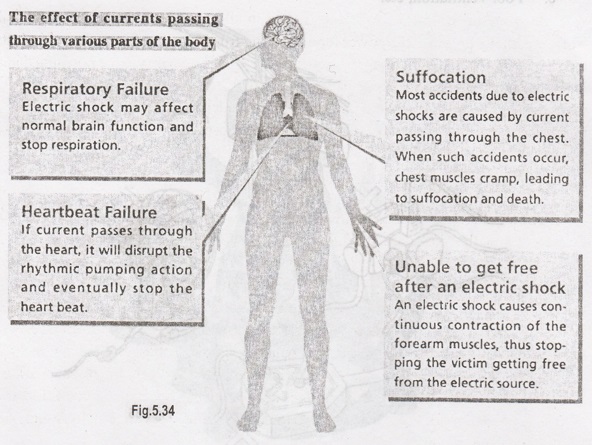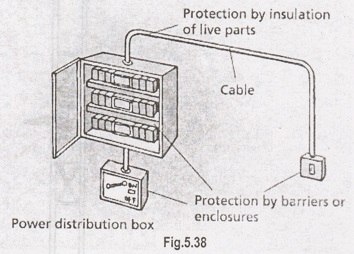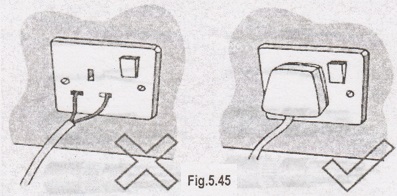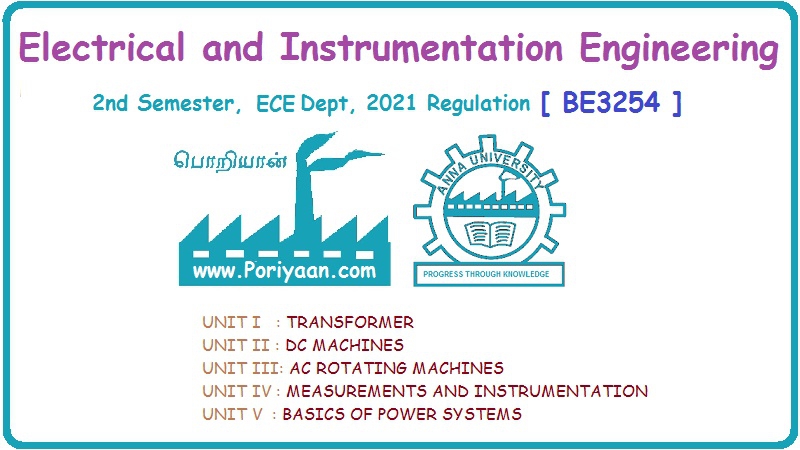Electrical and Instrumentation Engineering: Unit V: Basics of Power Systems
Electricity Safety Precautions and First Aides
As a source of power, electricity is used in all aspects of life. In the home and at work, electricity provides the power for everything from domestic appliances to industrial machines, from office equipment to electric tools.
SAFETY PRECAUTIONS AND FIRST AIDES
As
a source of power, electricity is used in all aspects of life. In the home and
at work, electricity provides the power for everything from domestic appliances
to industrial machines, from office equipment to electric tools. When compared
to the potential dangers of machinery and chemical substances, electrical
hazards can be easily overlooked. Unfortunately, this neglect often causes
serious accidents and loss of property. Many of these accidents can be
prevented as they are mainly caused by electricity users who lack basic safety
awareness.
Electrical safety legislation
The
legislation involving electrical safety is the "Electricity Ordinance
(Chapter 406)" as enforced by the Electrical and Mechanical Services
Department and "Factories and Industrial Undertakings (Electricity)
Regulations (Chapter 59)" enforced by the Labour Department. 2.1
Electricity Ordinance The Ordinance requires that people engaged in electricity
work, or with contractors and electricity generation facilities, must be
registered. It also stipulates the safety requirements of electricity supply,
electricity wiring and electrical products, etc. There are several subsidiary
regulations of the Electricity Ordinance, including: 1. Electricity Supply
Regulations 2. Electricity Supply (Special Areas) Regulations 3. Electricity
(Exemption) Regulations 4. Electricity (Registration) Regulations 5.
Electricity (Wiring) Regulations 6. Electrical Products (Safety) Regulation 7.
Electricity Supply Lines (Protection) Regulation.
Factories
and Industrial Undertakings (Electricity) Regulations The Regulations apply to
industrial undertakings in which electricity is generated, transformed,
distributed or used. The purpose is to supervise the safety of electrical
facilities and working processes, etc. of relevant industry.
1. Electrical hazards
Electric
shock refers to the electricity passing through the human body, affecting the
normal function of the heart, lungs and nervous system. Ventricular
fibrillation caused by electricity is the main reason for death from electric
shocks. Electric shocks may indirectly lead to accidents, e.g. falling from
heights and bruising due to body trauma etc. Ventricular fibrillation involves
a series of disordered contractions of the heart's ventricular muscle fibres,
which prevents regular heartbeat. Under normal conditions, the human heart rate
is from around 60 to 100 times per minute. During an electric shock, heartbeat
may increase up to several hundred times per minute. When the heart cannot sustain
such rapid contraction and relaxation, it may stop beating and cause death.
The
effect of currents passing through various parts of the body

2. Burns
During
an electric shock, the current passing through the body may lead to burns on
the skin, muscles or internal organs. As electric shocks and burns are closely
related, preventative measures should be considered together.
3. Fires and explosions
High
temperatures caused by currents under abnormal conditions, may result in
accidental fires and explosions. The common causes leading to high temperatures
include:
a.
Overloading of electricity
b.
Insulator breakdowns or short circuits.
c.
Improper contact of electrical circuit
d.
Improper maintenance of electrical appliances or wiring
e.
Poor ventilation, etc.

If
flames, sparks or metallic solutions due to electric arc welding are not
controlled, hazardous fires or explosions can occur.
4. Special process (electric arc
welding)
Electric
arc welding is commonly used for metallic welding and cutting. The various
hazards from welding or cutting include the following:
Hazards
Burns
Sparks
or hot metal fragments from arc welding or cutting may result in serious burns.
Proper protection is essential.
Radiation
If
proper eye protectors are not used while welding or cutting, radiation or other
objects may hurt the welder.

Safety
measures: Wear proper personal protective equipment, e.g. approved eye
protectors, hand shields, leather aprons, leather gloves and safety shoes, etc.
Electric
shock It is dangerous to conduct the arc welding in a wet environment or on
rainy days. Safety measures:
a.
Avoid electric welding in such conditions.
b.
Earth the tools and equipment properly.
c.
Adjust the current required for welding to the minimum amount.
d.
Add an automatic voltage regulator to reduce the open-circuit no-load voltage
orosis of the transformer output, reducing the chance of getting an electric
shock.
Poisonous fumes and gases
Inhalation
of poisonous fumes and gases during welding or cutting may cause serious health
problems. Safety measures:
a.
Provide adequate ventilation.
b.
Use exhaust systems to remove poisonous fumes and gases.

Protective measures for prevention of direct electrical contact
The
following procedures will prevent the human body from contact with electrical
conductors, wiring, electrical sources, etc.
Protective measures
Insulation
Shield
the electrical conductor with an insulator to prevent direct contact
Obstacles
Place
obstacles to prevent any accidental contact with the electrical conductor
Barriers or enclosures
Create
barriers or enclosures that prevent any direct contact with the electrical
conductor
Placing out of reach
This
prevents accidental contact with the electrical conductor



Safety devices
1. Fuse
Normally,
a fuse is a copper wiring with a set current fusion value. If the current
exceeds the set fusion value, the fuse will blow and the current is cut-off, thus
preventing overloading.
A fuse must be installed on
"live" wires. When replacing a fuse, the new
fuse must be same current fusion value as the old one.

2. Circuit breakers (MCB)
Circuit
breakers are based on the principle of the electromagnetic field. The current
entered may enable the coils of the circuit breaker to magnetize. When the
current exceeds the set value (i.e., Overloading), the magnetization
intensifies, switching off the circuit breaker and disconnecting the electric
source.

3. Earthing
Earthing
provides a low resistance way of discharging electricity to the ground in case
of current Leakage. This means that during an electric shock, the current
passes through the "earth" wire and is prevented from entering the
human body and causing injury.

Safe use of electricity
1. Safe use of plugs
Specification
of electric plugs

Plugs for electrical equipment shall match the power/current rating (calculated by voltage 220V).
2. Connection of plugs
Electrical
and Mechanical Services Department announced the new colour code for those
electrical installation works on or after 1 July 2007. From now on, new colour
code should be used for all new electrical installation works.


Brown
or red to Live (L)
Blue
or black to Neutral (N)
Yellow/green
or green to Earth (E or )
3. Safety hints
i)
Use correct plugs. Never insert the core of the cord directly into a socket.

ii)
Unplug by pulling the plug - not the cord.

iii)
Do not touch the plug with wet hands, as wet skin reduces the resistance of the
body, resulting in more serious injuries.

iv)
Broken plugs must be replaced immediately.

v)
Avoid overloading! Never put too many plugs into the same socket.

Electrical and Instrumentation Engineering: Unit V: Basics of Power Systems : Tag: : - Electricity Safety Precautions and First Aides
Related Topics
Related Subjects
Electrical and Instrumentation Engineering
BE3254 - 2nd Semester - ECE Dept - 2021 Regulation | 2nd Semester ECE Dept 2021 Regulation
